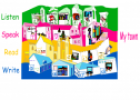Cargando...
Recursos educativos
-
Nivel educativo
-
Competencias
-
Tipología
-
Idioma
-
Tipo de medio
-
Tipo de actividad
-
Destinatarios
-
Tipo de audiencia
-
Creador
-

Self-evaluation 10 - Rivers and seas
EduBook Organización
- 6787 visitas
Choose the best answer to each question: What does the flow of a rainfall regime river depend on? How do we take advantage of the Earth's water? What is the relationship between rivers and relief?…
-

Population and work
EduBook Organización
- 6570 visitas
5.1. The active and inactive population When analysing a country's development, we study the relationship between the population and work. There are two types of population: The active population.…
-

Didactic unit: My town
Xtec Organización
- 26 lo usan
- 11299 visitas
This resource consists of a didactic unit. It is a set of activities focused on description of towns and cities, services and building. We learn to ask for and give information to find different places…
-

Summaries - A bipolar world: the cold war and decolonisation (1945-1991)
EduBook Organización
- 6250 visitas
1. The formation of opposing blocs (1945-1947) The end of the Second World War brought the tension between the United States and the Soviet Union to the forefront of the international stage. Each…
-

The natural environment. Ecosystems
EduBook Organización
- 6149 visitas
Most of the energy used by living things originally comes from sunlight which is trapped by autotrophs (or producers). This energy is then transferred from the producers to all other living things…
-

-

Introduction - A bipolar world: the cold war and decolonisation (1945-1991)
EduBook Organización
- 5875 visitas
Between 1945 and 1991, the world was divided into two opposing blocs: the Eastern Bloc (socialism), led by the USSR and the Western Bloc (capitalism), controlled by the United States of America. Western…
-

Answer true or false
EduBook Organización
- 5694 visitas
Answer true or false: There are four sectors of economic activity. → Arable farming, livestock farming and tourism are the main activities in the primary sector. → The chemical industry…
-

Final self-evaluation 12.05 - The Population of Spain
EduBook Organización
- 5517 visitas
Complete these sentences with the missing words: Castile-La Mancha (26,6 hab./km2) and (26,6 hab./km2), are two of Spain's less populated Autonomous Communities. In general, the population dynamic…
-

Complete. The formation of opposing blocs
EduBook Organización
- 5476 visitas
Complete these sentences about the formation of opposing blocs with the missing words: After the Second World War, the Yalta and Conferences divided Europe into distinct areas. The two represented…
Te estamos redirigiendo a la ficha del libro...












